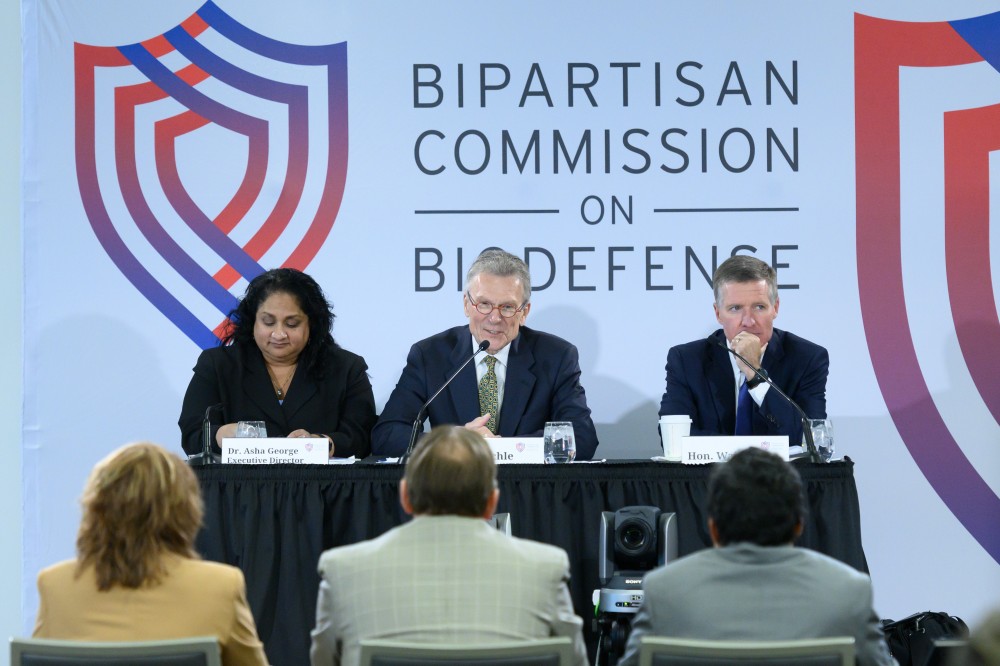
The nation’s land grant universities play an important role in helping the federal government bolster agro-defense, according to scientists, policymakers, industry and academic leaders who participated in a recent Bipartisan Commission on Biodefense event held at Colorado State University (CSU).
“More than a century ago, Congress distributed land to education institutions across the country to further our understanding about a number of issues, including agriculture,” said former U.S Sen. Tom Daschle from South Dakota, who serves as a commissioner on the Bipartisan Commission on Biodefense and led the event.
“Land grant universities have become a staple of their communities. Now a resource, the government should make more of an effort to work with them to improve agro-defense,” Daschle said.
In its October 2017 report, Defense of Animal Agriculture, the Bipartisan Commission on Biodefense analyzed the need to address vulnerabilities to animal health, Daschle said during its Nov. 5 event entitled, Too great a thing to leave undone: defense of agriculture.
The commission now plans to add to its previous recommendations in that report and will expand its review to include other aspects of agricultural security, including the national security role played by both land grant universities and public-private partnerships, he added.
And while some of the commission’s recommendations in its 2017 report most recently ended up in the 2018 Farm Bill, Daschle said, “There is much, much more work to be done.”
CSU Vice President for Research Alan Rudolph said during his panel discussion that the university is among the nation’s leading institutions able to help protect U.S. agricultural industries from infectious diseases.
“We aim to advance our ongoing efforts in preparedness that focus on research in surveillance and diagnosis for disease, vaccine and therapeutics treatments development, and remediation to enable return to normal operations after outbreaks,” Rudolph said.
He pointed out that CSU serves a critical role in helping the local region understand new threats, as well as how “to help prepare and respond to continued threats from disease.”
“We do that through our integrated mission of education, research and service, and through direct engagement with our communities,” said Rudolph.
For example, CSU researchers are able to collaborate with experts at 29 federal laboratories that are located near the university and is actively hiring researchers in sustainable agriculture disciplines, said Rudolph, who predicted that 30 to 40 new scientists focused on livestock health will be hired.
Additionally, land-grant universities like CSU are the hatching ground for new companies involved in the agricultural sector supply chain, he said, adding that CSU also maintains BioMARC, a biological manufacturing and academic resource center that produces vaccines, diagnostics and cell therapeutics.
“Colorado State University has been at the forefront of battling infectious diseases worldwide and promoting human and animal health for decades,” U.S. Rep. Joe Neguse (D-CO) said during the commission’s event, noting that food security is intertwined with national security.
But many gaps remain, the congressman said, and Congress must prioritize such issues.
For example, adequate vaccines continue to be an ongoing area of concern, said Rudolph, who pointed to the ongoing mass outbreak worldwide of African Swine fever, a viral disease that could kill at least a quarter of the world’s pig population and which has no vaccine, according to the World Organization for Animal Health.
Experts during the first panel discussed responding to such naturally occurring outbreaks having large-scale consequences.
“We are woefully ill-prepared for such an event,” said Lee Leachman, managing partner at the Leachman Cattle Company of Colorado.
Dr. Keith Roehr, DVM State Veterinarian at the Colorado Department of Agriculture, said that livestock producers in the United States also dread the spread of foot and mouth disease (FMD), which farmers and ranchers say could be devastating and impact the nation’s livestock trade for a significant period of time.
FMD is a severe, highly contagious viral disease in which animals typically have a fever and blisters on the tongue and lips, in and around the mouth, on the mammary glands, and around the hooves. Most affected animals will not die from FMD, but the disease leaves them weakened and unable to produce meat and milk the way they did before, according to the U.S. Department of Agriculture’s (USDA) Animal and Plant Health Inspection Service.
Roehr, who said the current FMD vaccine is inadequate, noted that the United States still lacks a comprehensive national system to respond to such highly contagious diseases and suggested that preparation and response to such threats be led by the USDA, which could strengthen biosecurity and disease prevention plans with strategies that businesses could quickly ramp up in their operations, for instance.
And because animal transferability is “exceedingly important,” as well, traceability systems must merge into one system for federal, state and local users, he said.
“We can’t afford to wait,” said Roehr.
Surveillance and detection also was a topic of discussion with federal and private-sector representatives describing existing requirements for monitoring animal and plant diseases before and during agricultural events.
U.S. Public Health Service Capt. Casey Barton Behravesh, DVM and director of the One Health Office at the National Center for Emerging and Zoonotic Infectious Diseases at the Centers for Disease Control and Prevention, said that no single industry sector can face such threats alone, so collaboration is essential.
“A one-health approach is needed,” she said.
Former U.S. Secretary of Agriculture Tom Vilsack, who appeared via a video recording, made several recommendations, including that the federal government work more closely with land grant universities and in partnership with farms, such as by providing them with sufficient prevention training materials.
“The better equipped and trained and prepared we are, the better off we’ll be to more easily detect problems and have an immediate response,” said Vilsack.
Early detection also can result in vaccine development and increased stockpiles, he added.




